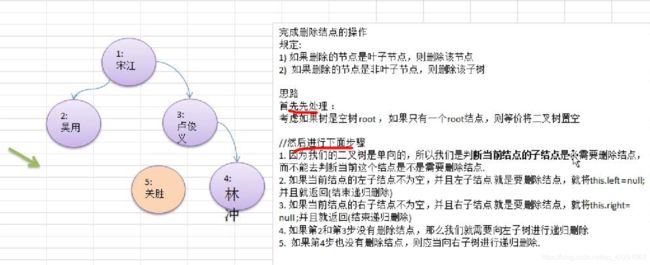二叉树的基本原理和实现方法(Java)
二叉树的来源:
数组存储方式的分析
优点:通过下标方式访问元素,速度快。对于有序数组,还可使用二分查找提高检索速度。 缺点:如果要检索具体某个值,或者插入值(按一定顺序)会整体移动,效率较低

链式存储方式的分析
优点:在一定程度上对数组存储方式有优化(比如:插入一个数值节点,只需要将插入节点,链接到链表中即可, 删除效率也很好)。 缺点:在进行检索时,效率仍然较低,比如(检索某个值,需要从头节点开始遍历) 
树存储方式的分析
能提高数据存储,读取的效率, 比如利用 二叉排序树(Binary Sort Tree),既可以保证数据的检索速度,同时也可以保证数据的插入,删除,修改的速度。

树的示意图以及常用术语:

结点的度(Degree):结点的子树个数;
树的度:树的所有结点中最大的度数;
叶结点(Leaf):度为0的结点;
父结点(Parent):有子树的结点是其子树的根节点的父结点;
子结点/孩子结点(Child):若A结点是B结点的父结点,则称B结点是A结点的子结点;
兄弟结点(Sibling):具有同一个父结点的各结点彼此是兄弟结点;
路径和路径长度:从结点n1到nk的路径为一个结点序列n1,n2,…,nk。ni是ni+1的父结点。路径所包含边的个数为路径的长度;
祖先结点(Ancestor):沿树根到某一结点路径上的所有结点都是这个结点的祖先结点;
子孙结点(Descendant):某一结点的子树中的所有结点是这个结点的子孙;
结点的层次(Level):规定根结点在1层,其他任一结点的层数是其父结点的层数加1;
树的深度(Depth):树中所有结点中的最大层次是这棵树的深度;
二叉树的概念:
①、树有很多种,每个节点最多只能有两个子节点的一种形式称为二叉树。
②、二叉树的子节点分为左节点和右节点。
③、如果该二叉树的所有叶子节点都在最后一层,并且结点总数= 2^n -1 , n 为层数,则我们称为满二叉树。
④、如果该二叉树的所有叶子节点都在最后一层或者倒数第二层,而且最后一层的叶子节点在左边连续,倒数第二层的叶子节点在右边连续,我们称为完全二叉树。
分析二叉树
前序、中序、后续遍历思路:
前序遍历: 先输出父节点,再遍历左子树和右子树
中序遍历: 先遍历左子树,再输出父节点,再遍历右子树
后序遍历: 先遍历左子树,再遍历右子树,最后输出父节点

前序、中序、后序查找思路:
删除节点思路分析:
代码实现前中后序遍历
package Tree;
/**
* 项目名称:algorithm
* 类名称:BinaryTreeDemo
* 创建人:Golven
* 创建时间:2019年10月26日 下午3:19:30
* @version
*/
public class BinaryTreeDemo {
@SuppressWarnings("null")
public static void main(String[] args) {
BinaryTree binaryTree = new BinaryTree();
HeroNode root = new HeroNode(1, "宋江");
HeroNode node2 = new HeroNode(2, "吴用");
HeroNode node3 = new HeroNode(3, "卢俊");
HeroNode node4 = new HeroNode(4, "林冲");
root.setLeft(node2);
root.setRight(node3);
node3.setRight(node4);
binaryTree.setRoot(root);
System.out.println("前序遍历:");
binaryTree.preOrder();
System.out.println("中序遍历:");
binaryTree.infixOrder();
System.out.println("后续遍历:");
binaryTree.postOrder();
// 前序遍历查找
System.out.println("前序遍历查找:");
HeroNode resNode = binaryTree.preOrderSearch(2);
if (resNode != null) {
System.out.printf("已找到节点,no=%d,name=%s\n", resNode.getNo(), resNode.getName());
} else {
System.out.printf("么有找到no=%d的英雄\n", 2);
}
// 中序遍历查找
System.out.println("中序遍历查找:");
HeroNode resNode2 = binaryTree.infixOrderSearch(2);
if (resNode2 != null) {
System.out.printf("已找到节点,no=%d,name=%s\n", resNode2.getNo(), resNode2.getName());
} else {
System.out.printf("么有找到no=%d的英雄", 2);
}
// 后序遍历查找
System.out.println("后序遍历查找:");
HeroNode resNode3 = binaryTree.postOrderSearch(2);
if (resNode3 != null) {
System.out.printf("已找到节点,no=%d,name=%s\n", resNode3.getNo(), resNode3.getName());
} else {
System.out.printf("么有找到no=%d的英雄", 2);
}
System.out.println("删除前,前序遍历查找:");
binaryTree.preOrder();
binaryTree.deleteNode(4);
System.out.println("删除后,前序遍历查找:");
binaryTree.preOrder();
}
}
//创建数
class BinaryTree {
private HeroNode root;
public void setRoot(HeroNode root) {
this.root = root;
}
// 前序遍历
public void preOrder() {
if (this.root != null) {
this.root.preOrder();
} else {
System.out.println("二叉树为空");
}
}
// 中序遍历
public void infixOrder() {
if (this.root != null) {
this.root.infixOrderr();
} else {
System.out.println("二叉树为空");
}
}
// 后序遍历
public void postOrder() {
if (this.root != null) {
this.root.postOrder();
} else {
System.out.println("二叉树为空");
}
}
// 前序遍历查找
public HeroNode preOrderSearch(int no) {
if (root != null) {
return root.preOrderSearch(no);
} else {
return null;
}
}
// 中序遍历查找
public HeroNode infixOrderSearch(int no) {
if (root != null) {
return root.infixOrderSearch(no);
} else {
return null;
}
}
// 后序遍历查找
public HeroNode postOrderSearch(int no) {
if (root != null) {
return root.postOrderSearch(no);
} else {
return null;
}
}
//删除节点
public void deleteNode(int no) {
//判断root是否为空
if(root!=null) {
//判断root是否为要删除的节点,因为之后就不会遍历到root了
if(root.getNo()==no) {
root = null;
}else {
root.deleteNode(no);
}
}else{
System.out.println("该二叉树为空!!");
}
}
}
//创建节点
class HeroNode {
private int no;
private String name;
private HeroNode left;
private HeroNode right;
public HeroNode(int no, String name) {
super();
this.no = no;
this.name = name;
}
public int getNo() {
return no;
}
public void setNo(int no) {
this.no = no;
}
public String getName() {
return name;
}
public void setName(String name) {
this.name = name;
}
public HeroNode getLeft() {
return left;
}
public void setLeft(HeroNode left) {
this.left = left;
}
public HeroNode getRight() {
return right;
}
public void setRight(HeroNode right) {
this.right = right;
}
@Override
public String toString() {
return "HeroNode [no=" + no + ", name=" + name + "]";
}
// 前序遍历
public void preOrder() {
System.out.println(this);// 先输出父节点
if (this.left != null) {
this.left.preOrder();
}
if (this.right != null) {
this.right.preOrder();
}
}
// 中序遍历
public void infixOrderr() {
if (this.left != null) {
this.left.infixOrderr();
}
System.out.println(this);// 输出父节点
if (this.right != null) {
this.right.infixOrderr();
}
}
// 后序遍历
public void postOrder() {
if (this.left != null) {
this.left.postOrder();
}
if (this.right != null) {
this.right.postOrder();
}
System.out.println(this);
}
// 前序遍历的查找
@SuppressWarnings("unused")
public HeroNode preOrderSearch(int no) {
System.out.println("进入前序遍历——");
if (this.no == no) {
return this;
}
HeroNode resNode = null;
// 判断该节点的左子节点是否为空,如果不为空,则向左进行递归查找
if (this.left != null) {
resNode = this.left.preOrderSearch(no);
}
if (resNode != null) {// 说明左子树已经找到
return resNode;
}
// 向右进行前序递归查找
if (this.right != null) {
resNode = this.right.preOrderSearch(no);
}
return resNode;
}
// 中序遍历查找
@SuppressWarnings("null")
public HeroNode infixOrderSearch(int no) {
HeroNode resNode = null;
if (this.left != null) {// 判断当前节点的左子节点是否为空,不为空,则向左递归
resNode = this.left.infixOrderSearch(no);
}
if (resNode != null) {
return resNode;
}
System.out.println("进入中序查找——");
// 比较当前节点
if (this.no == no) {
return this;
}
if (this.right != null) {
resNode.right.infixOrderr();
}
return resNode;
}
// 后序遍历查找
public HeroNode postOrderSearch(int no) {
HeroNode resNode = null;
if (this.left != null) {
resNode = this.left.postOrderSearch(no);
}
if (resNode != null) {// 向左递归找到
return resNode;
}
// 向右子数递归进行有序遍历查找
if (this.right != null) {
resNode = this.right.postOrderSearch(no);
}
if (resNode != null) {// 向右递归找到
return resNode;
}
// 如果左右子数都没右找到,则判断当前节点
System.out.println("进入后序查找——");
if (this.no == no) {
return this;
}
return resNode;
}
// 递归删除指定节点
// 思路
/*
* 1. 因为我们的二叉树是单向的,所以我们是判断当前结点的子结点是否需要删除结点,而不能去判断当前这个结点是不是需要删除结点.
* 2.如果当前结点的左子结点不为空,并且左子结点 就是要删除结点,就将this.left = null; 并且就返回(结束递归删除)
* 3.如果当前结点的右子结点不为空,并且右子结点 就是要删除结点,就将this.right= null ;并且就返回(结束递归删除)
* 4.如果第2和第3步没有删除结点,那么我们就需要向左子树进行递归删除 5. 如果第4步也没有删除结点,则应当向右子树进行递归删除.
*
*/
public void deleteNode(int no) {
//如果当前结点的左子结点不为空,并且左子结点 就是要删除结点,就将this.left = null; 并且就返回(结束递归删除)
if (this.left != null && this.left.no == no) {
this.left = null;
return;
}
//如果当前结点的右子结点不为空,并且右子结点 就是要删除结点,就将this.right= null ;并且就返回(结束递归删除)
if(this.right!=null&&this.right.no==no) {
this.right=null;
return;
}
//向左子树进行递归删除
if(this.left!=null) {
this.left.deleteNode(no);
}
//向右子树进行递归删除
if(this.right!=null) {
this.right.deleteNode(no);
}
}
}

